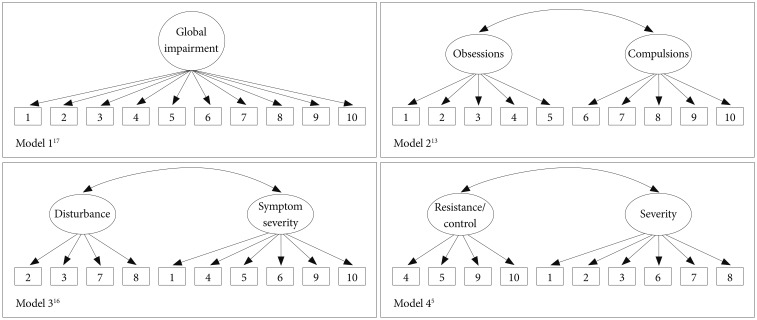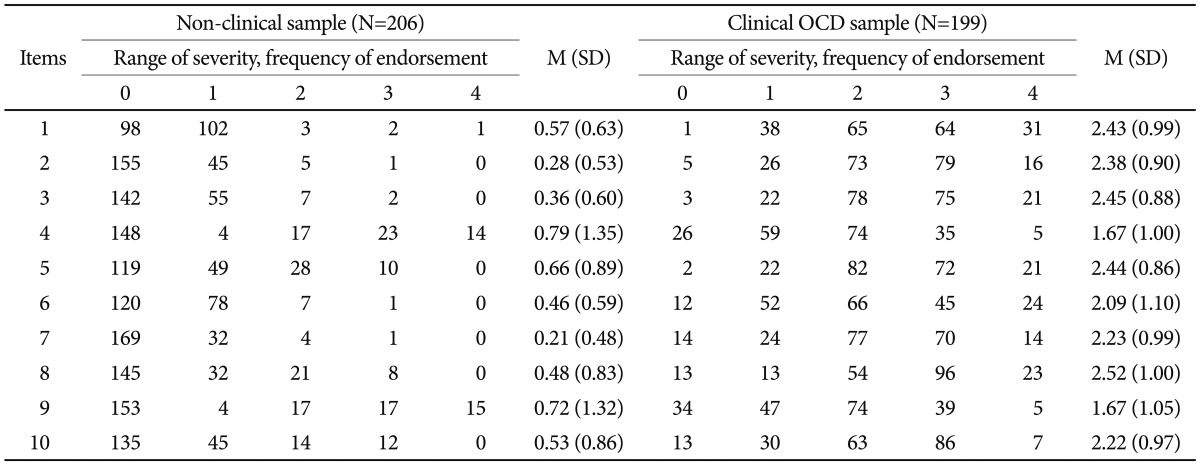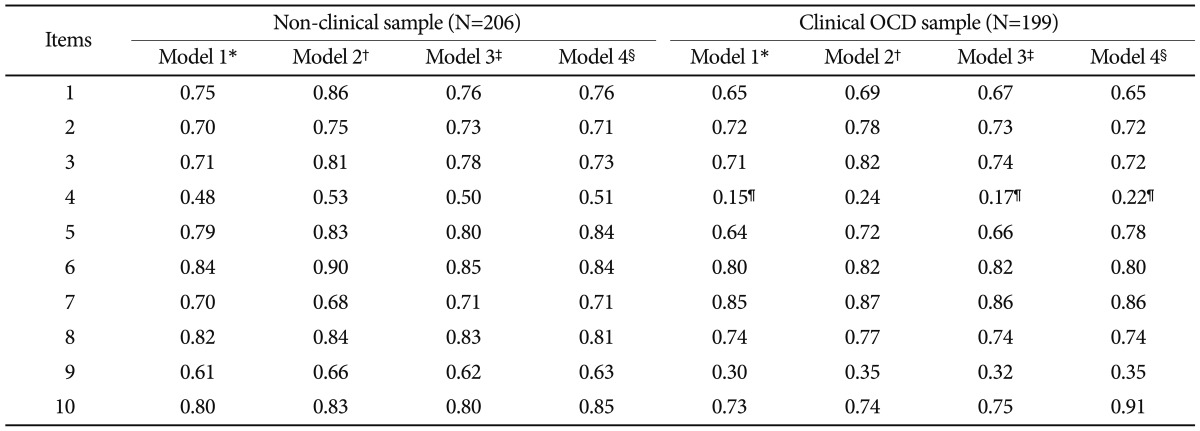1. Goodman WK, Price LH, Rasmussen SA, Mazure C, Fleischmann RL, Hill CL, et al. The Yale-Brown Obsessive Compulsive Scale. I. Development, use and reliability. Arch Gen Psychiatry 1989;46:1006-1011. PMID:
2684084.


2. Goodman WK, Price LH, Rasmussen SA, Mazure C, Delgado P, Heninger GR, et al. The Yale-Brown Obsessive Compulsive Scale. II. Validity. Arch Gen Psychiatry 1989;46:1012-1016. PMID:
2510699.


3. Storch EA, Rasmussen SA, Price LH, Larson MJ, Murphy TK, Goodman WK. Development and psychometric evaluation of the Yale-Brown Obsessive-Compulsive Scale--Second Edition. Psychol Assess 2010;22:223-232. PMID:
20528050.


4. Anholt GE, van Oppen P, Emmelkamp PMG, Cath DC, Smith JH, van Dyck R, et al. Measuring obsessive-compulsive symptoms: Padua Inventory-Revised vs. Yale-Brown Obsessive Compulsive Scale. J Anxiety Disord 2009;23:830-835. PMID:
19443176.


5. Deacon BJ, Abramowitz JS. The Yale-Brown Obsessive Compulsive Scale: factor analysis, construct validity, and suggestions for refinement. J Anxiety Disord 2005;19:573-585. PMID:
15749574.



6. Woody SR, Steketee G, Chambless DL. Reliability and validity of the Yale-Brown Obsessive Compulsive Scale. Behav Res Ther 1995;33:597-605. PMID:
7598684.


7. Frost RO, Steketee A, Krouse MS, Trepanier KL. The relationship of the Yale-Brown Obsessive Compulsive Scale (YBOCS) to other measures of obsessive compulsive symptoms in a nonclinical population. J Pers Assess 1995;65:158-168. PMID:
16367651.


8. Rosenfeld R, Dar R, Anderson D, Kobak KA, Greist JH. A computer-administered version of the Yale-Brown Obsessive-Compulsive Scale. Psychol Assess 1992;4:329-332.

9. Baer L. Getting Control: Overcoming Your Obsessions and Compulsion. 2000,2nd Edition. New York: A Plume Book.
10. Steketee G, Frost R, Bogard K. The Yale-Brown Obsessive Compulsive Scale: interview versus self-report. Behav Res Ther 1996;34:675-684. PMID:
8870295.


11. Federici A, Summerfeldt LJ, Harrington JL, McCabe RE, Purdon CL, Rowa K, et al. Consistency between self-report and clinician-administered versions of the Yale-Brown Obsessive-Compulsive Scale. J Anxiety Disord 2010;24:729-733. PMID:
20561767.


12. Marks IM, Cavanagh K, Gega L. Hands-on Help: Computer-Aided Psychotherapy. 2007,New York: Psychology Press.
13. McKay D, Danyko S, Neziroglu F, Yaryura-Tobias JA. Factor structure of the Yale-Brown Obsessive Compulsive Scale: a two dimensional measure. Behav Res Ther 1995;33:865-869. PMID:
7677726.


14. McKay D, Neziroglu F, Stevens K, Yaryura-Tobias JA. The Yale-Brown Obsessive Compulsive Scale: Confirmatory factor analytic findings. J Psychopathol Behav Assess 1998;20:265-274.

15. Storch EA, Shapira NA, Dimoulas E, Geffken GR, Murphy TK, Goodman WK. Yale-Brown Obsessive Compulsive Scale: the dimensional structure revised. Depress Anxiety 2005;22:28-35. PMID:
16130118.


16. Amir N, Foa EB, Coles ME. Factor structure of the Yale-Brown Obsessive Compulsive Scale. Psychol Assess 1997;9:312-316.

17. Fals-Stewart W. A dimensional analysis of the Yale-Brown Obsessive Compulsive Scale. Psychol Rep 1992;70:239-240. PMID:
1565726.


18. Kim SW, Dysken MW, Pheley AM, Hoover KM. The Yale-Brown Obsessive Compulsive Scale: measures of internal consistency. Psychiatry Res 1994;51:203-211. PMID:
8022954.


19. Moritz S, Meier B, Kloss M, Jacobson D, Wein C, Fricke S, et al. Dimensional structure of the Yale-Brown Obsessive Compulsive Scale (Y-BOCS). Psychiatry Res 2002;109:193-199. PMID:
11927144.


20. Garnaat SL, Norton PJ. Factor structure and measurement invariance of the Yale-Brown Obsessive Compulsive Scale across four racial/ethnic groups. J Anxiety Disord 2010;24:723-728. PMID:
20541907.



21. Rachman S, de Silva P. Abnormal and normal obsessions. Behav Res Ther 1978;16:233-248. PMID:
718588.



22. Gibbs NA. Nonclinical populations in research on OCD: a critical review. Clin Psychol Rev 1996;16:729-773.

23. Hodgson RJ, Rachman S. Obsessional-compulsive complaints. Behav Res Ther 1977;15:389-395. PMID:
612339.


24. Sanavio E. Obsessions and compulsions: the Padua Inventory. Behav Res Ther 1988;26:169-177. PMID:
3365207.


25. Steketee G, Barlow DH. In: Barlow DHObsessive-Compulsive Disorder. , editor. Anxiety and Its Disorders: The Nature and Treatment of Anxiety and Panic. 2004,New York: The Guilford Press, p. 516-550.
26. Beck AT. In: Williams TA, Katz MM, Shields JAMeasuring Depression: The Depression Inventory. , editor. Recent Advances in the Psychobiology of the Depressive Illness. 1972,Washington, DC: Government Printing Office, p. 299-322.
27. Beck AT, Steer RA. Manual for the Beck Anxiety Inventory. 1990,San Antonio, TX: Psychological Corporation.
28. American Psychiatric Association. Diagnostic and Statistical Manual of Mental Disorders. 1994,4th Edition. Washington, DC: American Psychiatric Association.
29. Emmerkamp PMG. In: Hearson M, Bellack ASMaudsley Obsessional Compulsive Inventory. , editor. Dictionary of Behavioral Assessment Techniques. 1988,New York: Pergamon Press, p. 294-296.
30. Beck AT, Steer RA, Garbin MG. Psychometric properties of the Beck Depression Inventory: twenty-five years of evaluation. Clin Psychol Rev 1988;8:77-100.

31. Kim GS. AMOS 18.0: Structural Equation Modeling. 2010,Seoul: Hannarae Publishing Co..
32. Cole DA. Utility of confirmatory factor analysis in test validation research. J Consult Clin Psychol 1987;55:584-594. PMID:
3624616.


33. Hu L, Bentler PM. Cutoff criteria for fit indexes in covariance structure analysis: conventional criteria versus new alternatives. Struct Equ Modeling 1999;6:1-55.

34. Brown MW, Cudeck R. In: Bollen KA, Long JSAlternative Ways of Assessing Model Fit. , editor. Testing Structural Equation Models. 1993,Beverly Hills, CA: Sage, p. 136-162.

35. Taylor S, Thordarson DS, Söchting I. In: Antony MM, Barlow DHObsessive-Compulsive Disorder. , editor. Handbook of Assessment and Treatment Planning for Psychological Disorders. 2002,New York: Guilford Press, p. 182-214.

36. Salkovskis PM. Understanding and treating obsessive-compulsive disorder. Behav Res Ther 1999;37(Suppl 1):S29-S52. PMID:
10402695.


37. Lewin AB, De Nadai AS, Park J, Goodman WK, Murphy TK, Storch EA. Refining clinical judgment of treatment outcome in obsessive-compulsive disorder. Psychiatry Res 2011;185:394-401. PMID:
20846725.

















